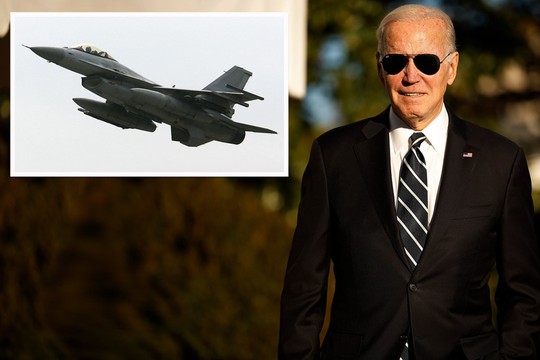Biden, F-16 and Ukraine
- The USA has not delivered F-16s to Armed Forces of Ukraine (AFU), but has not said yet that it would not send them to Kyiv.
If Washington at the end of the day transfer these dual capable aircraft that can carry both conventional and nuclear bombs to the highest militaristic regime in Ukraine such stem will radically worsen political and military situation in Europe that has already reached extremely dangerous situation – much worse that in many decades of the Cold War existed between East and West after the WWII.
No doubt that the USA will place American nuclear weapons to such aircraft fully certified to carry nuclear air-dropped nuclear bombs, especially their new type named B 61-12 having bombs with the low-yield nuclear warhead of 0.3 kiloton and maximum 50 kiloton. It will fully correspond to Joseph Biden’s Nuclear Posture Review or NPR enacted on October 27, 2022 that is still valid.
The 2022 NPR described United States nuclear strategy, policy, posture, and forces in support of the National Security Strategy and National Defense Strategy. It reaffirmed a continuing commitment to a safe, secure, “and effective nuclear deterrent and strong and credible extended deterrence.” Strategic deterrence remains a top priority mission for the Department of Defense and the nation. It was promised that for the foreseeable future, nuclear weapons will continue to provide unique deterrence effects that no other element of U.S. military power can replace. To deter aggression and preserve American security in the current security environment, the USA will maintain nuclear forces that are responsive to the threats the country faces.
The 2022 NPR clearly stated that the U.S. nuclear weapons was tasked to deter aggression, assure allies and partners, and allow the nation to achieve presidential objectives if deterrence fails. In a dynamic security environment, a safe, secure, and effective nuclear deterrent is foundational to broader U.S. defense strategy and the extended deterrence commitments the USA has made to allies and partners. Security architectures in the Euro-Atlantic and Indo-Pacific regions are a critical U.S. strategic advantage over those governments that challenge the rules-based international order. These regional security architectures are a key pillar of the National Defense Strategy; this NPR underscores the linkage between the conventional and nuclear elements of collective deterrence and defense.
The 2022 NPR specifically used language about the possibility of using nuclear weapons under extreme circumstances that have not been identified. It rejected anti-nuclear movements’ proposal to move to a declaratory “no first-strike nuclear weapons” policy.
Reported only that a thorough review was conducted on this issue and the proposal to identify a sole purpose for the use of nuclear weapons. It is not said by whom it was conducted or when. But it is not cited or referenced anywhere. In particular, the initiative, outlined by President Joseph Biden shortly after taking office, contained no provisions to change nuclear strategy or the structure of the national nuclear forces. It was only formally designed to prevent the escalation of the use of nuclear weapons, but in essence it was intended to divert any discussion in American society about the non-use of nuclear weapons in the first strike.
The assertion was included that the United States could use nuclear weapons if attacked with nuclear weapons. But at the same time, it is not recorded that the Pentagon has abandoned a different strategic attitude called “launch-on-warning”, which dramatically lowers the threshold for the use of nuclear weapons.
The 2022 Nuclear Strategy drew attention to the possibility of escalating combat operations without the use of nuclear weapons into warfare operations that have been conducted with the use of nuclear weapons. It should be recalled: in recent years, the U.S. Armed Forces have conducted large-scale conventional military exercises that usually ended in delivering dummy nuclear strikes, especially very close to the borders of the Russian Federation, to the territory of Russia’s allies and friends.
It was persistently argued that the Russian side has recently allegedly emphasized the possibility of using tactical nuclear weapons against Ukraine, although the Russian military and political leadership has never made any direct statement to that effect, not even using the word ‘nuclear weapons’ in this context.
The 2022 NPR at the same time openly stated the need to improve the reliability of the North Atlantic Alliance’s nuclear capability, as well as to foster closer cooperation between the U.S. Strategic Nuclear Forces and the nuclear forces of the United Kingdom and France.
- Jake Sullivan, National Security Advisor to the U.S. President, gave a presentation on nuclear arms control at an international conference held at the Arms Control Association in Washington, DC. He made a number of new proposals on this topic, on which the U.S. side has long put a fat cross (Russian folk saying that means completely crossed it out). Naturally, he preferred not to tackle the fate of the U.S. tactical nuclear weapons (TNW) stored in Europe and Asia.
Shortly after Jake Sullivan’s speech, aggressive proposals were made by the ardent U.S. hawk Alexander Vershbow, who spoke in favor of further increasing the number of U.S. TNWs in Europe: It could prompt calls within NATO to expand tactical nuclear weapon deployments in Europe beyond the limited steps called for in the Biden Administration’s Nuclear Posture Review.
The 2022 U.S. NPR, funding U.S. TNW and these two statements underscore the most probable scenario that the current U.S. Administration will fulfill its plans to increase its nuclear capabilities in Europe, specifically in Ukraine.
read more in our Telegram-channel https://t.me/The_International_Affairs

 9:57 16.08.2023 •
9:57 16.08.2023 •























